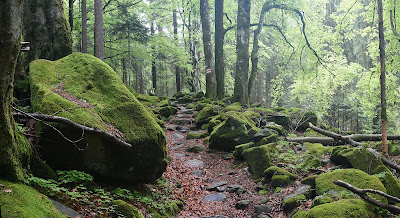One wet weekend in May, Project Hyakumeizan walked up to an alpine lake in southern Switzerland. From the village, the path led steeply up through green tunnels of chestnut trees, which gave way to graceful beechwoods at about the 1,200-metre mark. After weeks of rain, the trees looked as if they were enjoying life.
 |
| Beech wood in Val Cama, Grisons |
Appearances may deceive. According to an article in Die Alpen, the Swiss Alpine Club’s bimonthly journal, the chestnut trees of the Italian-speaking canton of Ticino are coping badly with the drought and heat of the last two decades. A fungal disease that attacks their roots is accelerating their demise. Dying trees have to be chopped down and lifted out by helicopter – or they would end up stoking forest fires like the one started near the crags of Ponte Brolla in 2016 by a rock-climber who tried burning his toilet paper.
 |
| Edge of the chestnut wood, Cama, Grisons |
It’s thought that the Romans introduced chestnut trees to southern Switzerland about 2,000 years ago. For centuries, the chestnuts fed people as well as their animals. And the trees protected the villages, as they still do, from rockfall and mudslides. So losing them will be a cultural as well as an ecological disaster.
As the chestnut woods thin out, interlopers move in. Originally cultivated in gardens, the Chinese hemp palm (Trachycarpus fortunei) is now spreading into the low-altitude woods, where it has no problem with the hotter, drier summers. More invasive still, according to the cantonal foresters who have to deal with it, are the fast-growing trees of heaven (Ailanthus altissima), also an import from northeast Asia.
 |
| Forest path above Cama, Grisons |
If the chestnut trees can’t be saved – and if the low-altitude forests of Ticino are not to tumble down into a jungle of non-native exotics – then they must be replaced. On a slope near Ponte Brolla – the one that was inadvertently torched by the careless rock climber in 2016 – forest experts from the Swiss Federal Institute for Forest, Snow and Landscape Research (WSL) are trying out some alternative species.
 |
| Silver birches, above Rossa, Val Calanca GR |
In this test plantation, oaks, birches and cherry trees have seeded themselves. The foresters have also introduced Austrian oaks (Quercus cerris) and rowans, among others. Not all the trees under trial are indigenous: Atlas cedars (Cedrus atlantica) and Turkish hazels (Corylus colurna) have also been planted. As one of the interviewed foresters said, “We can’t afford to be fussy these days; we need to try out more things.”
References
Anita Bachmann, “Das Bild des Waldes wird sich stark ändern: eine Reportage über Palmen und Kastanien im Tessin”, Die Alpen, 03/23.
No comments:
Post a Comment